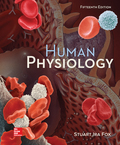
Concept explainers
List the components of an atom and explain how they are organized. Explain why different atoms are able to form characteristic numbers of
To review:
Composition and organization of atoms and the bonding of atoms with a specific number of subsidiary atoms.
Introduction:
The smallest particles of matter are known as atoms. The term atom was coined by Democritus (Greek philosopher) in 440 BC. The word atom originated from atoms means indivisible. The notion of indivisibility was adopted by many people until it was broken by J. J. Thomson in 1897 with the discovery of electrons.
Explanation of Solution
Atoms are composed of three subatomic particles called neutrons, protons, and electrons. Neutrons and protons are located inside the nucleus (at the center of an atom). Electrons are present around the nucleus in energy shells called orbitals. Protons bear positive charge and electrons bear negative charge. Neutrons do not contain any charge. The electrons present in the outermost shells participate in the bond formation with adjacent atoms. These electrons present in the outer shell are termed valence electrons. For example, hydrogen and sodium have only one valence electron but oxygen and sulfur have two valence electrons in their outermost shell.
During a chemical reaction, atoms form bonds between themselves by donating, gaining, or sharing of the valence electrons. Ionic bonds are formed by donating or receiving electrons, but sharing of electrons lead to the formation of covalent bonds. Each electron forms only one chemical bond. Since the number of valence electrons are limited and vary according to an element, thus, each atom can formulate only a certain number of chemical bonds. For example, sodium has an excess electron in the outermost shell and chlorine contains seven electrons in the outermost shell. Chlorine and sodium, both try to complete their outermost shell (octet) by donating or gaining electrons. Thus, sodium donates an electron that is received by chlorine to form an ionic bond between these elements.
Want to see more full solutions like this?
Chapter 2 Solutions
EBK HUMAN PHYSIOLOGY
- Not part of a graded assignment, from a past midtermarrow_forwardNoggin mutation: The mouse, one of the phenotypic consequences of Noggin mutationis mispatterning of the spinal cord, in the posterior region of the mouse embryo, suchthat in the hindlimb region the more ventral fates are lost, and the dorsal Pax3 domain isexpanded. (this experiment is not in the lectures).a. Hypothesis for why: What would be your hypothesis for why the ventral fatesare lost and dorsal fates expanded? Include in your answer the words notochord,BMP, SHH and either (or both of) surface ectoderm or lateral plate mesodermarrow_forwardNot part of a graded assignment, from a past midtermarrow_forward
- Explain in a flowcharts organazing the words down below: genetics Chromosomes Inheritance DNA & Genes Mutations Proteinsarrow_forwardplease helparrow_forwardWhat does the heavy dark line along collecting duct tell us about water reabsorption in this individual at this time? What does the heavy dark line along collecting duct tell us about ADH secretion in this individual at this time?arrow_forward
 Principles Of Radiographic Imaging: An Art And A ...Health & NutritionISBN:9781337711067Author:Richard R. Carlton, Arlene M. Adler, Vesna BalacPublisher:Cengage Learning
Principles Of Radiographic Imaging: An Art And A ...Health & NutritionISBN:9781337711067Author:Richard R. Carlton, Arlene M. Adler, Vesna BalacPublisher:Cengage Learning Human Biology (MindTap Course List)BiologyISBN:9781305112100Author:Cecie Starr, Beverly McMillanPublisher:Cengage Learning
Human Biology (MindTap Course List)BiologyISBN:9781305112100Author:Cecie Starr, Beverly McMillanPublisher:Cengage Learning Concepts of BiologyBiologyISBN:9781938168116Author:Samantha Fowler, Rebecca Roush, James WisePublisher:OpenStax College
Concepts of BiologyBiologyISBN:9781938168116Author:Samantha Fowler, Rebecca Roush, James WisePublisher:OpenStax College Biology (MindTap Course List)BiologyISBN:9781337392938Author:Eldra Solomon, Charles Martin, Diana W. Martin, Linda R. BergPublisher:Cengage Learning
Biology (MindTap Course List)BiologyISBN:9781337392938Author:Eldra Solomon, Charles Martin, Diana W. Martin, Linda R. BergPublisher:Cengage Learning





